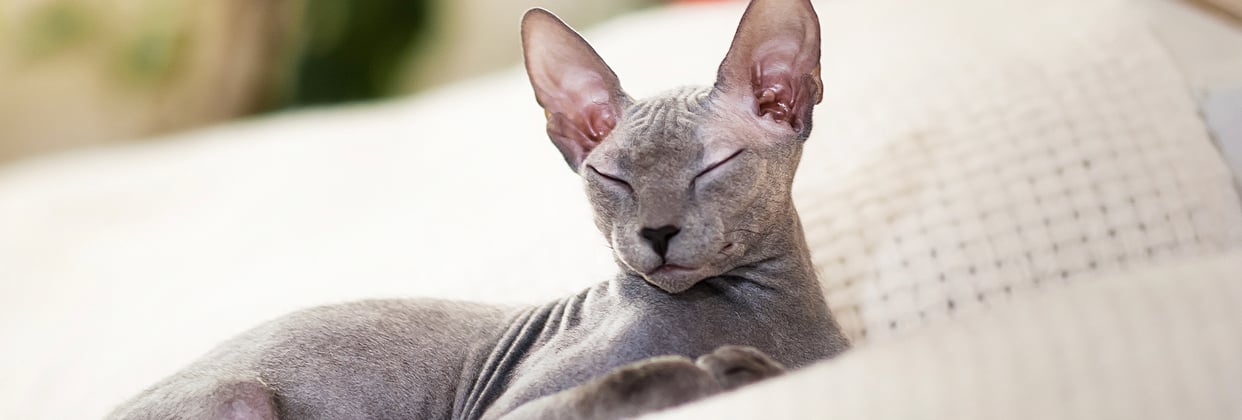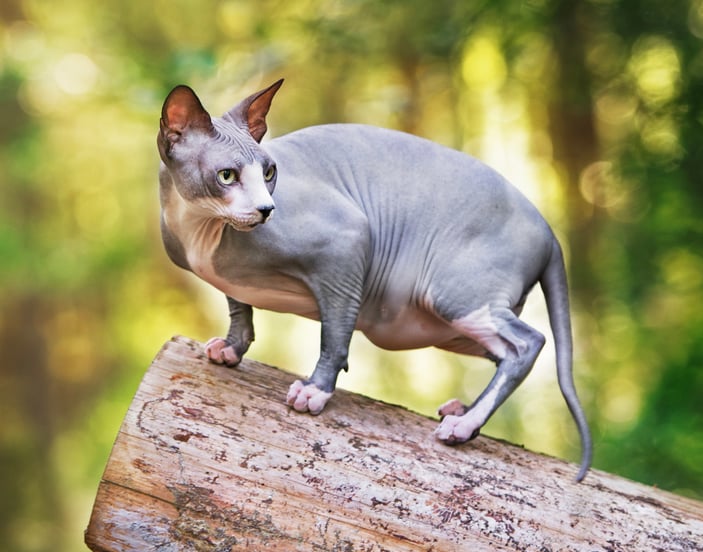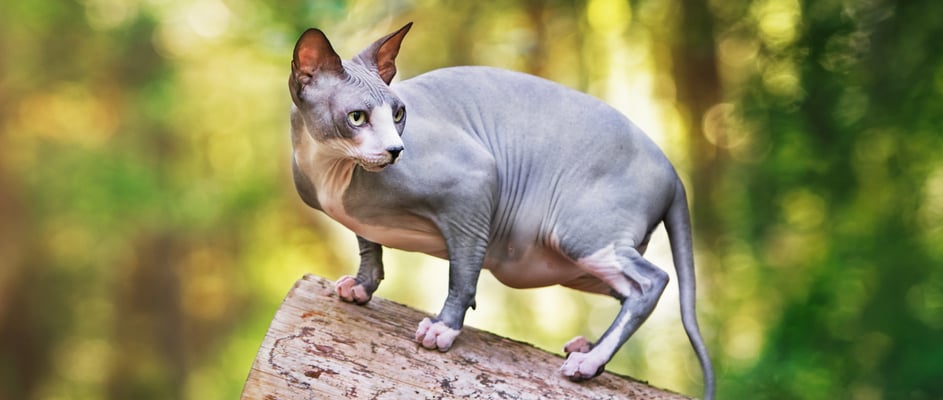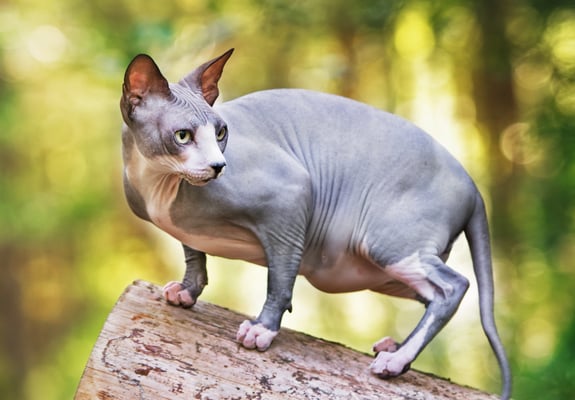The guide to owning a Sphynx cat.
Looking to welcome a cat into your home but not sure where to begin? Welcome, you’re in the right place. Secure a no-obligation quote with Waggel to make sure your new friend gets the cover they deserve.
Jump to:
Stats at a glance.
History of the Sphynx cat.
Did you know the Canadian Sphynx came from a genetic mutation in the 1960s? Early breeders aimed to produce a breed with a hairless appearance, free of major health issues.
Over time, cat fanciers embraced this charming feline, shaping the modern Sphynx cats we see today.
Sometimes called Canadian hairless, they owe their beginnings to a handful of hairless kitten litters that intrigued breeders around the globe.
It’s said these pioneers fell in love with the cat’s curious, people-oriented personality, and so a new breed of cats was developed with help from domestic shorthair lines.
The result? A purring, wrinkly wonder with a heart of gold.


Physical characteristics.
Sphynx cats come in a dazzling array of skin pigmentations. You might notice pinkish, grey, or even spotted variations. Their bodies are graceful yet sturdy, with long legs that support their playful leaps.
They often sport a wedge-shaped head, complete with large eyes and ears that lend them a near-mythic look. Some have very fine fur over their bodies, while others are entirely bare.
Because of their lack of coat, many Sphynx cats may be warm to the touch. If you think your new cat feels like a hot water bottle, you’re not imagining things. Their exposed skin simply radiates extra body heat.
Colours and patterns.
Even though we call them hairless Sphynx, subtle patterns sometimes appear.
Some are almost pure pink; others show faint tabby lines or darker pigmentation across the back.
These patterns aren’t fur-based but come from the cat’s skin markings. Because the lack of hair means we see skin tone directly, you can spot colours easily, especially on the face and tail.





Temperament and personality.
A Sphynx cat is typically sociable and outgoing. They’re quick to snuggle up on your lap, especially if there’s a cosy blanket around. We’ve noticed how they tend to crave warmth, so a soft cat bed by the radiator can be paradise.
These pets absolutely love interaction and may follow you from room to room. Some even learn to play fetch with a small soft toy, especially with positive reinforcement.
If you’re after a calm, rarely seen feline, this might not be the right choice. These cats are keen to greet visitors and might try to climb onto shoulders just to say hello.


Health considerations.
Because of their lack of coat, Sphynx cats need a bit of extra support. They risk sunburn if they lounge in direct sunlight, so we suggest limiting intense sun exposure.
They can have a slight tendency for oil buildup, which is why routine bathing is crucial. It’s also important to watch out for skin irritations.
If you ever see signs of redness or unusual rashes, a check-up with your vet is best. To stay on top of unexpected vet costs, investing in pet insurance can ease many worries. You can read more details in our cat insurance guide.
Additionally, some lines of Sphynx kitten can inherit heart issues or dental problems. Many experts recommend regular scans to catch potential heart changes early.
Keep an eye on weight, too. They tend to eat more than other felines just to keep warm. Balanced meals can prevent problems down the line.
Living with a Sphynx cat.
Getting a Sphynx means welcoming a friendly shadow into your life. They prefer to be wherever you are, whether that’s the sofa or your desk. If you’ve never owned a hairless cat before, you’ll quickly learn that they love heat and soft fabrics. Providing a heated cat bed or thick blanket can keep them happy on frosty nights.
Since they’re an indoor-oriented species, it’s wise to protect them from the sun and extreme cold.
They can adapt well to apartment living as long as there are cat trees or shelves to climb. If you’d like to let them walk on a lead outdoors, just be mindful of the weather and keep an eye out for potential chills.


Grooming and care.
You might think a hairless Sphynx never needs grooming, but lack of hair doesn’t mean zero upkeep. In fact, as mentioned earlier, regular bathing is key.
Weekly or fortnightly baths help remove excess oils that can build up on their skin. If you’re new to washing a cat, you can get practical pointers from our how to bathe a cat guide.
Remember to groom the nails and clean the ears too. Wax can accumulate faster in hairless environments, so gentle ear cleaning is beneficial. Also take a peek at their whisker area, as some Sphynx have extremely short whiskers that need checking from time to time.
For dryness or irritated patches, a vet-recommended moisturiser can help. Make sure it’s formulated for pets. And if you want more tips on everyday coat (or in this case, skin) maintenance, you might enjoy our cat grooming guide tips.


Diet and exercise.
Despite being low-shedding, these cats aren’t low-energy. Sphynx cats love to climb, chase toy mice, and cuddle in warm spots.
Feeding a top-quality dry food plus some wet options will help them keep a steady weight. Because they need to stay warm, they burn more calories than many breeds.
A balanced diet is crucial. Add interactive toys or puzzle feeders if they seem bored.
A couple of short play sessions each day often does the trick. Using positive reinforcement like treats or gentle praise will encourage them to stay active without becoming anxious.


Is a Sphynx cat right for you?
If you've learned what you need to know about Sphynx cats and want a friend who’s always ready to greet you at the door, you might love this hairless hypoallergenic breed. While no cat is guaranteed allergen-free, the Sphynx is known for producing fewer allergens for many folks, thanks to lack of hair. Still, it’s wise to test the waters if you have severe allergies.
They thrive in households where they get daily attention. If you’re often away, consider adopting two so they can keep each other company. If you’re looking for Sphynx kittens for sale, be sure to seek a reputable breeder who ensures kittens are litter trained, healthy, and well socialised.
We also encourage folks to check breed-specific rescues or shelters, as a new cat might be waiting there. This can give a Sphynx girl or boy a wonderful second chance.
Frequently asked questions.
Is a Sphynx cat hypoallergenic?
They’re often called hypoallergenic because of their lack of coat, but total allergen-free status is never guaranteed. Some people find Sphynx dander less troublesome than a fluffy shorthair though.
How do I choose a Sphynx kitten?
Start by looking for a quality breeder. Make sure the kittens are healthy, playful, and come from a line tested for common genetic issues. If possible, meet the parents to see their temperament. Or, try rescues that specialise in these hairless cat sweeties.
Are Sphynx cats good family pets?
Most are gentle, affectionate, and sociable with children and other pets. They just ask for warm places to nap and plenty of cuddle sessions. Always teach kids to handle them gently.


What is the price of a Sphynx cat?
Costs vary widely. In the UK, it is around £200-£1,600, while show-quality Sphynx can run into higher figures. Always research Sphynx breeders thoroughly or look for rehoming and adoption options.
Do Sphynx cats get along with dogs?
Yes, if the introductions are done gradually. Many Sphynx cats enjoy canine playmates. Remember to monitor early interactions and use positive reinforcement to ensure a calm environment.
Do Sphynx cats need outdoor access?
They can adapt to secure indoor living. Because their lack of hair means they’re sensitive to temperature, many owners either keep them inside or use an enclosed patio. They’re prone to burns or chills if left unprotected outside.
Pet insurance for Sphynx cats.
Despite their lack of fur, a Sphynx cat can bring endless warmth, literally and emotionally into your life.
From their curious stare to their friendly purr, they’re more than just a cat with a cute wrinkled forehead, they're family.
Once you share your home with these charming characters, chances are you’ll never look back.
If you have more questions about cat health, head over to our causes and issues of hair loss and alopecia in cats or our cat grooming guide tips for extra insights.
And don't forget to get an insurance quote if you are a parent of the Sphynx breed already.
Above all, enjoy building a close bond with your new spirited, intelligent cat.


